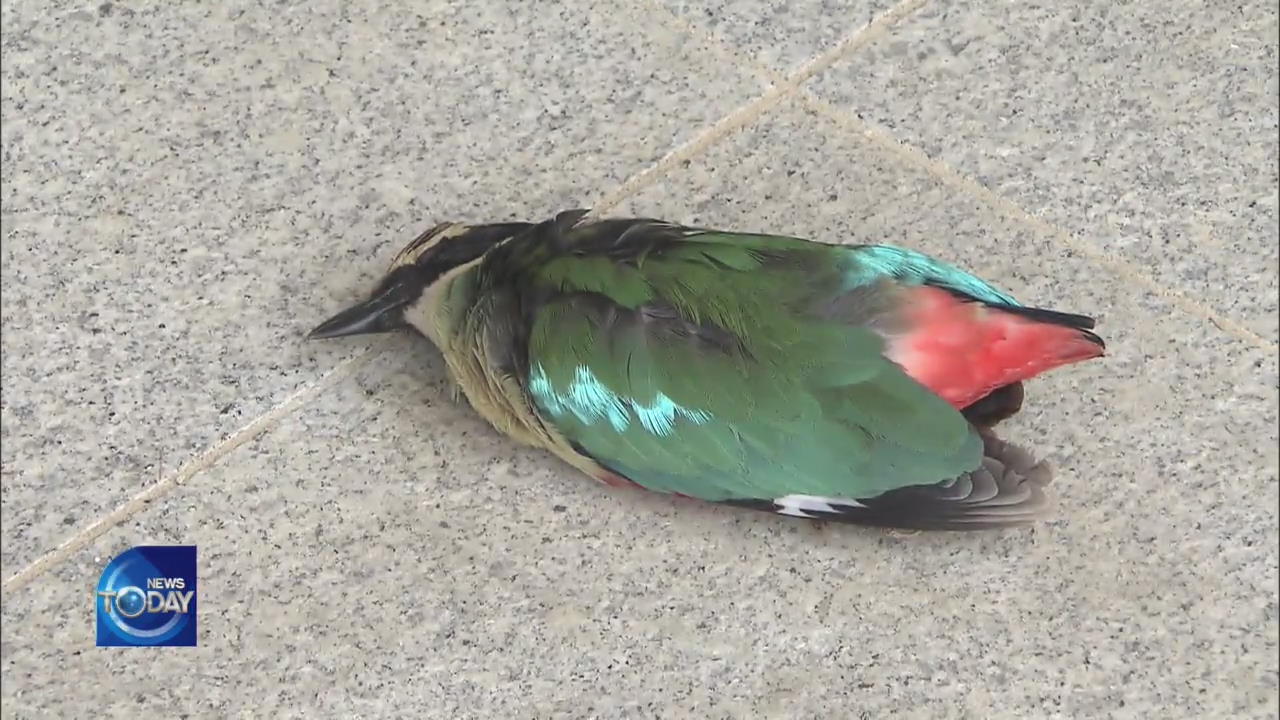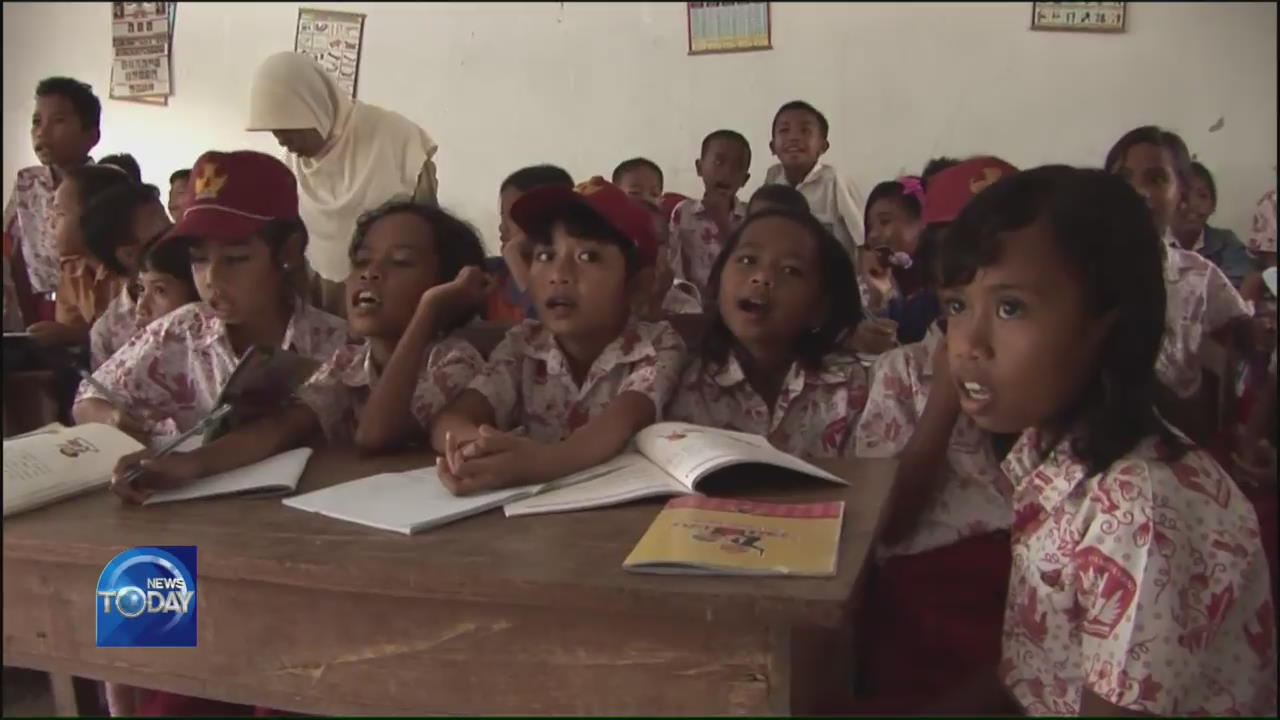MIGRATORY BIRD RISKS
입력 2019.06.24 (15:06)
수정 2019.06.24 (17:10)
읽어주기 기능은 크롬기반의
브라우저에서만 사용하실 수 있습니다.
[Anchor Lead]
Designated as Natural Monument No. 204, the fairy pitta is a migratory bird that spends the summer in Korea. But in recent days, the birds are known to be faced with a risk of colliding with glass windows. We take you to Gyeongsangnam-do Province for the details.
[Pkg]
A stiffened bird was found on the ground. It's a fairy pitta, which is Korean Natural Monument No. 204 and known for its beautiful, multicolored feathers of green and sky blue with red dots on the tail. It was found dead last month in front of the entrance to a community center in Namhae-gun County, Gyeongsangnam-do Province.
[Soundbite] BAEK SANG-YEON(DISCOVERER OF DEAD FAIRY PITTA) : "It appeared to have died after colliding with glass. I wrapped it in a newspaper and kept it in a refrigerator."
Likewise, in an ecological park in Tongyeong, Gyeongsangnam-do Province, a fairy pitta died after colliding with the glass wall of a building on June 5. In Gyeongsangnam-do Province alone, five fairy pittas crashed into buildings and died in a period of just one month. The birds come to Korea during their mating season. But they crash into glass walls and windows as well as buildings built in forests. According to a study conducted by the Environment Ministry and the National Institute of Ecology, about 8 million wild birds collide with glass structures and die in Korea annually. Stickers showing images of predatory birds are ineffective in preventing such accidents. In an effort to protect these birds, the Environment Ministry is now promoting a rule, which requires the use of glass windows dotted with patterns drawn at intervals of five centimeters in length and ten centimeters in width.
[Soundbite] KIM YOUNG-JOON(NIE) : "It is known that birds recognize glass windows with patterns at intervals of five centimeters in length and ten centimeters in width."
This patterned glass has been found to be effective in Daejeon. In order to save wild birds from these deadly collisions with glass, the ministry will introduce such preventive measures across the nation this year.
Designated as Natural Monument No. 204, the fairy pitta is a migratory bird that spends the summer in Korea. But in recent days, the birds are known to be faced with a risk of colliding with glass windows. We take you to Gyeongsangnam-do Province for the details.
[Pkg]
A stiffened bird was found on the ground. It's a fairy pitta, which is Korean Natural Monument No. 204 and known for its beautiful, multicolored feathers of green and sky blue with red dots on the tail. It was found dead last month in front of the entrance to a community center in Namhae-gun County, Gyeongsangnam-do Province.
[Soundbite] BAEK SANG-YEON(DISCOVERER OF DEAD FAIRY PITTA) : "It appeared to have died after colliding with glass. I wrapped it in a newspaper and kept it in a refrigerator."
Likewise, in an ecological park in Tongyeong, Gyeongsangnam-do Province, a fairy pitta died after colliding with the glass wall of a building on June 5. In Gyeongsangnam-do Province alone, five fairy pittas crashed into buildings and died in a period of just one month. The birds come to Korea during their mating season. But they crash into glass walls and windows as well as buildings built in forests. According to a study conducted by the Environment Ministry and the National Institute of Ecology, about 8 million wild birds collide with glass structures and die in Korea annually. Stickers showing images of predatory birds are ineffective in preventing such accidents. In an effort to protect these birds, the Environment Ministry is now promoting a rule, which requires the use of glass windows dotted with patterns drawn at intervals of five centimeters in length and ten centimeters in width.
[Soundbite] KIM YOUNG-JOON(NIE) : "It is known that birds recognize glass windows with patterns at intervals of five centimeters in length and ten centimeters in width."
This patterned glass has been found to be effective in Daejeon. In order to save wild birds from these deadly collisions with glass, the ministry will introduce such preventive measures across the nation this year.
■ 제보하기
▷ 카카오톡 : 'KBS제보' 검색, 채널 추가
▷ 전화 : 02-781-1234, 4444
▷ 이메일 : kbs1234@kbs.co.kr
▷ 유튜브, 네이버, 카카오에서도 KBS뉴스를 구독해주세요!
- MIGRATORY BIRD RISKS
-
- 입력 2019-06-24 14:58:13
- 수정2019-06-24 17:10:39

[Anchor Lead]
Designated as Natural Monument No. 204, the fairy pitta is a migratory bird that spends the summer in Korea. But in recent days, the birds are known to be faced with a risk of colliding with glass windows. We take you to Gyeongsangnam-do Province for the details.
[Pkg]
A stiffened bird was found on the ground. It's a fairy pitta, which is Korean Natural Monument No. 204 and known for its beautiful, multicolored feathers of green and sky blue with red dots on the tail. It was found dead last month in front of the entrance to a community center in Namhae-gun County, Gyeongsangnam-do Province.
[Soundbite] BAEK SANG-YEON(DISCOVERER OF DEAD FAIRY PITTA) : "It appeared to have died after colliding with glass. I wrapped it in a newspaper and kept it in a refrigerator."
Likewise, in an ecological park in Tongyeong, Gyeongsangnam-do Province, a fairy pitta died after colliding with the glass wall of a building on June 5. In Gyeongsangnam-do Province alone, five fairy pittas crashed into buildings and died in a period of just one month. The birds come to Korea during their mating season. But they crash into glass walls and windows as well as buildings built in forests. According to a study conducted by the Environment Ministry and the National Institute of Ecology, about 8 million wild birds collide with glass structures and die in Korea annually. Stickers showing images of predatory birds are ineffective in preventing such accidents. In an effort to protect these birds, the Environment Ministry is now promoting a rule, which requires the use of glass windows dotted with patterns drawn at intervals of five centimeters in length and ten centimeters in width.
[Soundbite] KIM YOUNG-JOON(NIE) : "It is known that birds recognize glass windows with patterns at intervals of five centimeters in length and ten centimeters in width."
This patterned glass has been found to be effective in Daejeon. In order to save wild birds from these deadly collisions with glass, the ministry will introduce such preventive measures across the nation this year.
Designated as Natural Monument No. 204, the fairy pitta is a migratory bird that spends the summer in Korea. But in recent days, the birds are known to be faced with a risk of colliding with glass windows. We take you to Gyeongsangnam-do Province for the details.
[Pkg]
A stiffened bird was found on the ground. It's a fairy pitta, which is Korean Natural Monument No. 204 and known for its beautiful, multicolored feathers of green and sky blue with red dots on the tail. It was found dead last month in front of the entrance to a community center in Namhae-gun County, Gyeongsangnam-do Province.
[Soundbite] BAEK SANG-YEON(DISCOVERER OF DEAD FAIRY PITTA) : "It appeared to have died after colliding with glass. I wrapped it in a newspaper and kept it in a refrigerator."
Likewise, in an ecological park in Tongyeong, Gyeongsangnam-do Province, a fairy pitta died after colliding with the glass wall of a building on June 5. In Gyeongsangnam-do Province alone, five fairy pittas crashed into buildings and died in a period of just one month. The birds come to Korea during their mating season. But they crash into glass walls and windows as well as buildings built in forests. According to a study conducted by the Environment Ministry and the National Institute of Ecology, about 8 million wild birds collide with glass structures and die in Korea annually. Stickers showing images of predatory birds are ineffective in preventing such accidents. In an effort to protect these birds, the Environment Ministry is now promoting a rule, which requires the use of glass windows dotted with patterns drawn at intervals of five centimeters in length and ten centimeters in width.
[Soundbite] KIM YOUNG-JOON(NIE) : "It is known that birds recognize glass windows with patterns at intervals of five centimeters in length and ten centimeters in width."
This patterned glass has been found to be effective in Daejeon. In order to save wild birds from these deadly collisions with glass, the ministry will introduce such preventive measures across the nation this year.
이 기사가 좋으셨다면
-
좋아요
0
-
응원해요
0
-
후속 원해요
0














![[단독] 골프연습장 아니라더니<br>…‘한남동 골프연습장’ 도면 입수](/data/news/2025/07/01/20250701_Uh8Jnu.png)


이 기사에 대한 의견을 남겨주세요.